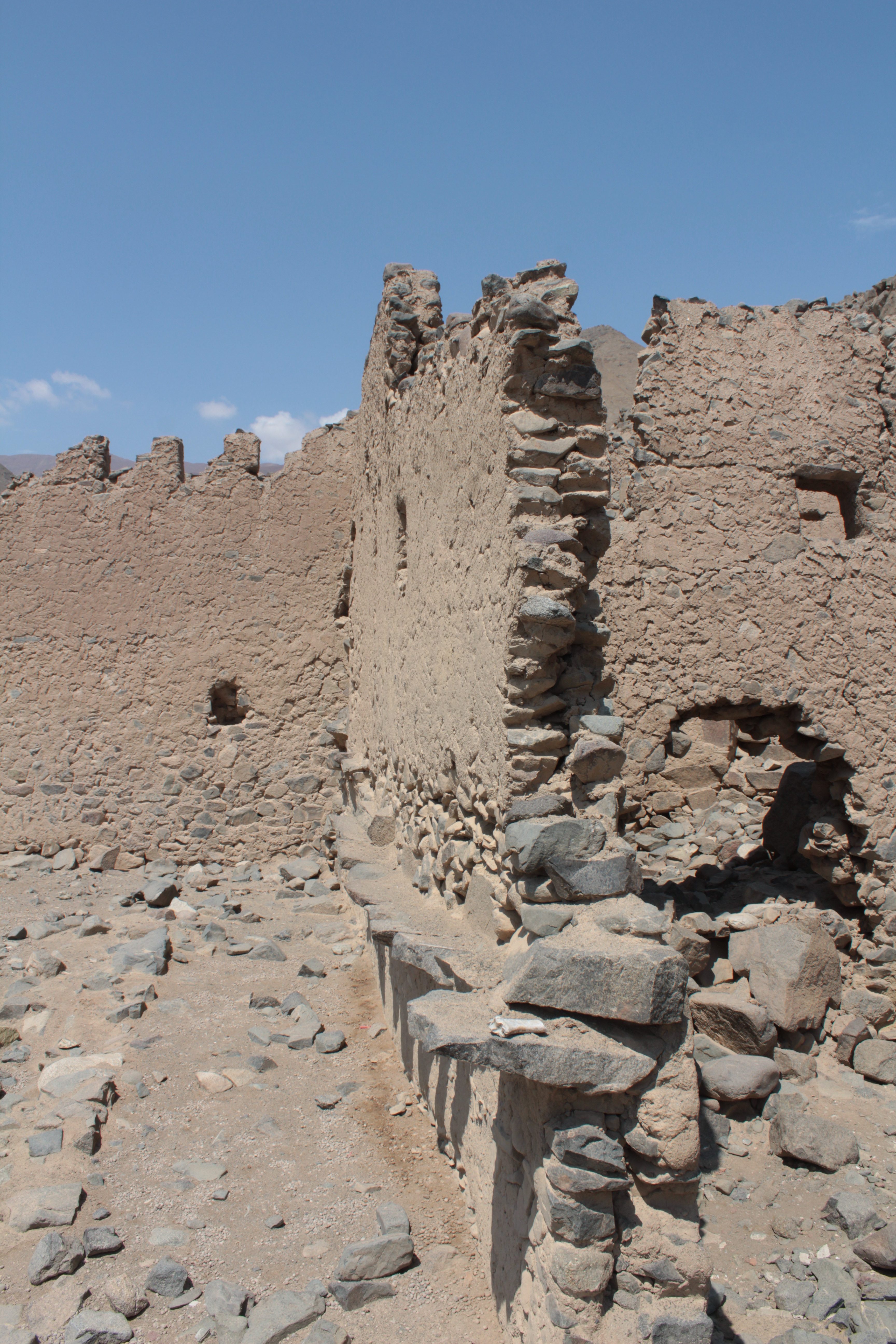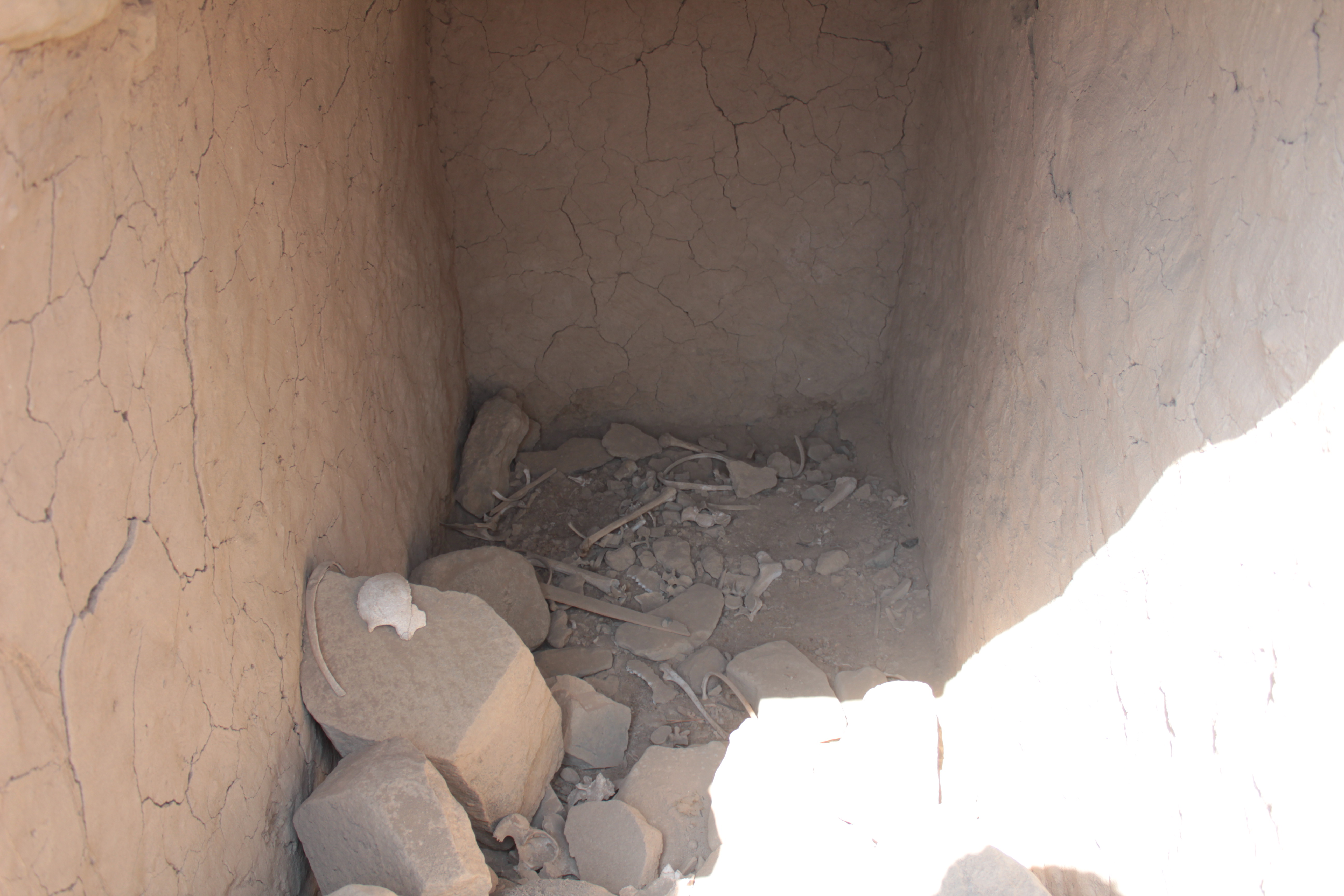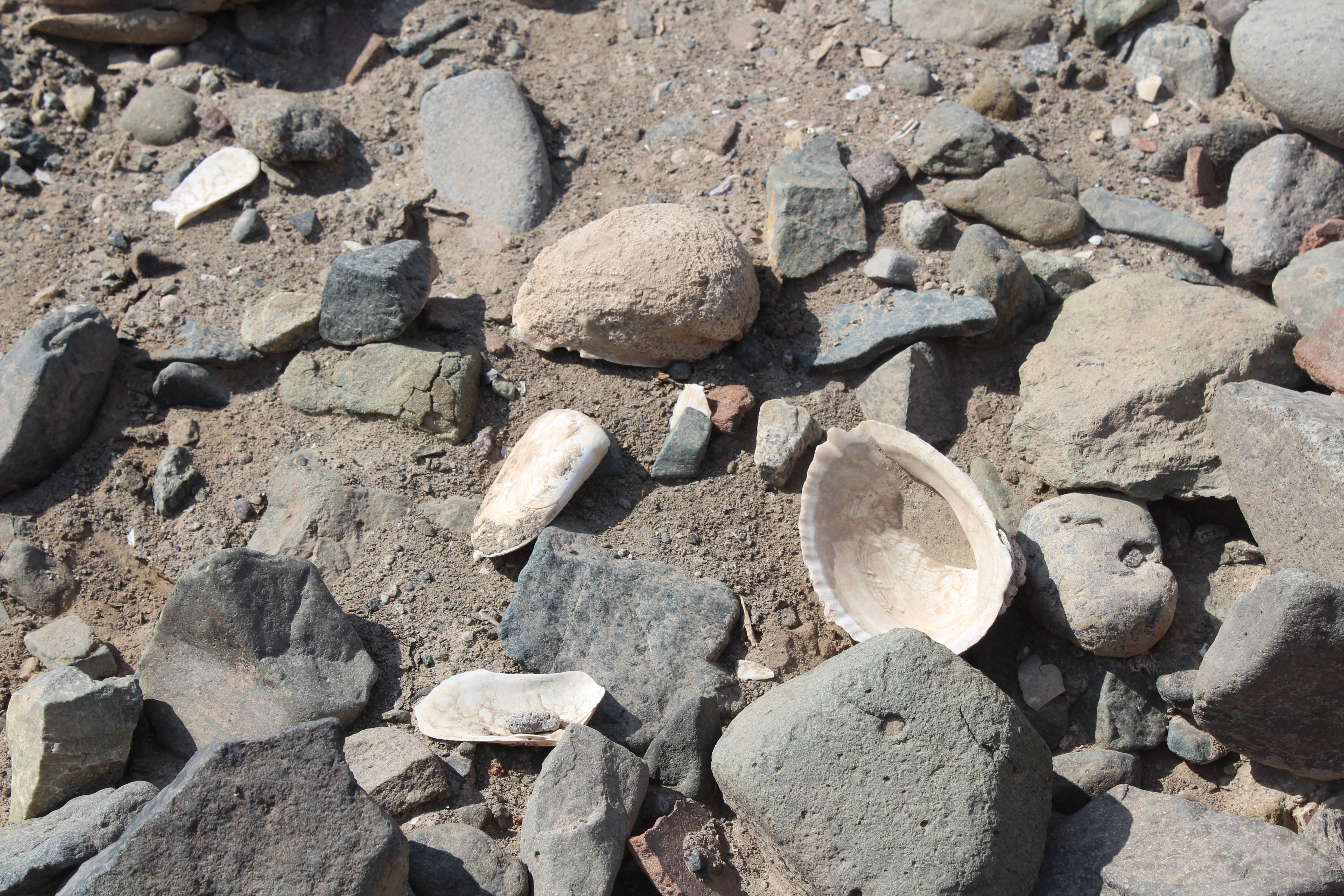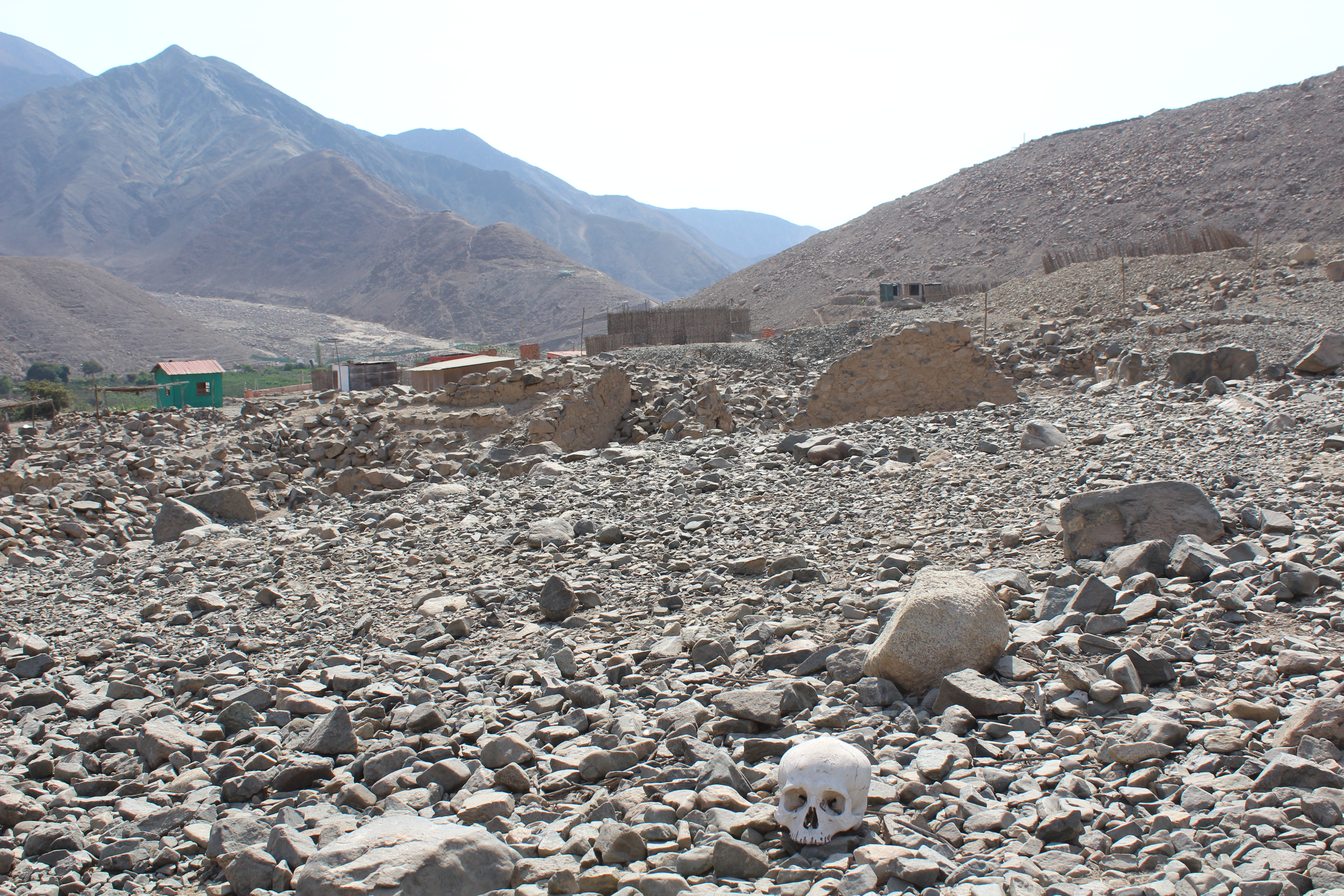The next step was to find this Erasmo Quispe “who knows about the stone”. Returning to Calango, I got off the bus at the plaza by the church. It was a picture of colonial order. Twelve flamboyant trees shading slat benches surrounded a central band stand, with diagonal walkways and ornate cast iron lamp stands. At the northern side, two flagpoles flanked a bust of Mariscal Andres el Caceres, facing the district offices, the Municipalidad. The whole of the southern side of the plaza was taken up by the church, faced with orange plaster.
A woman is sitting by a table in a shop doorway on a corner of the plaza. I take out my photos of a low flat stone surrounded by reeds that had accompanied a tourism article about Calango in the national press.
“I am looking for a stone with drawings on it by the river. The girl in the municipality told me that Erasmo Quispe could show me.”
“Erasmo, yes he is here, but he is having lunch now.”
She points across the corner of the plaza to the Municipality offices opposite. “He works there. He will be back at two thirty”.
“Thats great. I will get some lunch and come back later.” And I make to walk to the other side of the Plaza.
“Wait!” she jumps up. “Where are you going?”
I point to the signboard across the road “MENU …sopa de verduras…papa huancaina….tallarin verde…caldo de gallina…” The restaurant?”
“But we have lunch here! Have a seat!” and Angela hustles me to a table.
As I start on a salad of lettuce, broccoli, avocado and cucumber with a lime dressing she brings a solemn little man over to my table. Reggis Pomalaya Godoy works in the municipal offices, she tells me. He has come across the plaza to have his lunch.
“So” he says to me, holding his hands together and bowing his head, speaking slowly and reverentially. “how does it appear to you, Calango?”
“So peaceful after Lima,” I roll out my usual response. “The people are friendly. And it is very beautiful, with trees and the river.”
“Ah yes. And this is your first visit?”
“I have been here several times investigating the stones here. I am looking for another stone over the river.” I show him the photograph from the newspaper article.
“This is higher up the valley, at Minay. But there is one here. In the museum. Have you seen it?”
“Yes I have seen it, but I believe there are two more here. A priest writing in 1638 said that the indios told him of two more stones near Calango.” I bring out my photocopies of Antonio de la Calancha`s writings.
He glances at them. “An archaeologist did a study of the valley and recorded 162 sites of interest. La Vuelta, Coyahuasi, Huancani, Minay, Checas. Checas was a very big pueblo. There are even condors higher up, beyond Checas, as the ravine narrows. I have all the reports in my office.” He closed his eyes and nodded. “I can show you them later.”
“I would appreciate that.”
He continues “So you know this region? I was in the municipality in Quilmana, in San Antonio, in Flores, in Calango” – a succession of small district outposts – “but I teach at the university, business systems. Do you know Quilmana?”
“Yes I do. I have a friend with a chacra. Marco Polo…”
Ah, I know him, he is a friend of mine, he is a footballer. Very tall.”
I tried to adjust to what “very tall” meant in this context. Yes, Marco Polo at almost six feet would qualify.
“I have a chacra there. It is watered by acequias (irrigation canals). I grow maize and quinoa and beans and peppers.”
“That`s wonderful.”
“Give me your number. I have a project that I would like you to help me with….”
I divert him with a rambling explanation of everything I had discovered in the valley, and never heard about the project. After finishing his lunch he tells me, “Come and see me at 2.30 and I will show you our documents.”
I cross to the municipal building ten minutes later and stand in the empty entrance hall looking for somewhere to sign in or for a receptionist to direct me. As I wai there Angela comes across to direct me.”Was that alright?” she asks me. “Was I right to introduce him to you?”
I assure her he had been very helpful as she lead me up three flights of stairs and showed me Reggis´ office.
He makes several peremptory and very important phone calls whilst I sat there. A girl from the floor below brings me a glossy tourist folder about Calango. “And where are the files, the rest of the documents?” Reggis says roughly. “You must bring me all the papers immediately.”
I glance at the folder as I waited. It encloses a disk, which I presume has information about the district, and is printed front and back with colourful scenes from around Calango – a dish of camarones, the rocky grotto of La Capilla, with its scrubbed and painted stone and oils of Peru`s saints, fields of apple trees in blossom, and a procession carrying an image of the Virgen de Candelaria.
Two gentlemen wander into the hot airless room talking about the grade 6.8 earthquake experienced in Arequipa, to the south, that morning at 4.18 am. They look more useful than Reggis.
“Excuse me, do you know Ernesto Quispe?”
“Ernesto?”
“ah…Erasmo?”
“Yes. I am he.”
Erasmo was tall and formal with greying hair, dressed like a civil servant. I introduce myself and he shook my hand.
“I have been studying the petroglyphs here,” I said, “and I think there may be more stones in Calango.”
I show him my photograph from a newspaper web site trumpeting the tourist delights of the district, showing a low flat stone by the river.
“I think this may be by the river in Calango.”
“This is in Checas. There are two stones in Checas.” He spoke with complete authority.
“By the ruins?”
“Down by the river. And there are two stones in Minay, down by the river.”
He picked up the brochure I had been given from the desk in front of me and turned it over. There is a photograph of a rock I had never seen before.
“This one is in Minay.”
The photograph showed a grey rock decorated with concentric circles, llamas, T-shapes and more. The rock was river smoothed and grey, but the markings showed out dark against the lighter stone.
“There could be more stones in Calango,” I say, “One across the river, and one higher up the valley. Antonio de la Calancha writes that, when he visited this town in 1638, the indians told him of two other stones.”
Now he seems interested. I bring out the copies I have of the seventeenth century manuscript and hand it to him. He paces the room as he reads it aloud.
“The indians took me twelve blocks from town to a plain in the valley above, where they sow coca. Here, they showed me on a flat rock the appearance of a large body that is wrapped in a shroud, for it has its feet together, and I saw the heels, the calves and the thighs, the elbows neck and head.”
“That sounds like it could be up in the fields between here and the bend in the river” I say. He nods and continues.
“The indians told me that a tall white man had come, and slept one night on the flat stone. He placed his foot on the stone in the town, and left his other footprint across the river, as he was leaving for faraway places.”
We walk to the window and look across the river, where a great reddish stone as high as a house standa above the grey pebbled shore on the far bank.
“There´s a stone over there” I say, obviously.
“Can I take a copy of your papers?” he asks.
And at three o´clock, the policeman leaves the office to move his official vehicle from the western side of the square, where it had been parked beneath the flamboyant tree, to the east, behind the church, as the sun moves across the sky and shifts the patches of shade.
On his computer Erasmo has a folder, “about Calango”. I catch a glimpse of the names of some of the images, documents and subfolders: myths, History, ... Erasmo is the source, perhaps the author, of everything of import that I had previously been able to discover on the web. He is the mother lode. I had hit pay dirt.
There were several other things I wanted to ask him about.
“I saw on Google Earth there is a path going up the hillside from the quebrada seca, the dry ravine, that goes up from the iron bridge. I wondered if it was going to some mines.”
“It leads to an Inca shrine. There is a great flat rock that you can lie down on. And near it is an intihuatana.”
He walked to the window and pointed across the river to some low walls of stone and adobe.
“The Qapac Ñan, the Inca road, goes up from those buildings high behind that peak. It is so wide” – a metre or more – “I have walked it.”
He tellsme more about his explorations in the valley, and in return I give him my copy of the writings of Antonio de la Calancha.
I cycle back towards Mala, and my phone bursts into life as I approach the signal mast for the town.
Reggis has sent me a series of photographs, the first showing the man himself seated at
his desk, followed by him sitting with a group of students in the grounds of a school, posters for an event he had organised in Quilmana, and various Leche por Vida groups, Milk for Life, a child feeding programme to reduce the chronic anaemia suffered by over 40% of chidren under three years of age in Peru. He seems like an ambitious man, who for all his ambition has not advanced very far, from one small town office to another.
The next day I head up the valley by bike towards La Vuelta. Had Erasmo said there was a stone there? I rest my bike against the wall of the deserted municipality building and walk across a football pitch – no grass, just recently levelled land, my feet sinking into grey dust at each step and raising clouds of dust. On the far side is a track leading past crowing cockerels and a pen of goats. There are one or two proto-houses, four thin walls of plywood, but they are deserted. Ahead is an open area. On the far side I can see remains of walls of plastered stone and adobe, buildings and groups of buildings. The open area is fenced off and a sign says private property. But there is no wire between the fence posts. I walk on.

There is a low walled corral to the right, and at the back is a high wall with a ledge of flat stones projecting at waist height. Behind it are smaller rooms, some with floors dug up to reveal recesses below. It appears to be a structure of low rooms below and larger spaces above, with narrow passageways.
The walls are built of stone, with a facing of adobe. The stonework that remains is finely done, linear foundations of large flat rocks, tall walls with a base of large stones, fingerwork still evident on some of the clay worked between the stones, other walls plastered flat and polished smooth.


The corral appears a new addition, a modern yard for animals. The rear building has several levels. Below ground there appear to have been burials, to judge from the craters in the floors and the scattered bones. The flat projecting stones may have supported an upper floor. A opening to the rear, has a lintel, still intact, of river canes coated in clay. It feels more like a burrow with narrow corridors, tiny rooms, and sunken chambers.
Across the modern track is a second complex of buildings surrounded by an oval external wall. The wall is over two metres high, mostly still in good condition, with two small entrance doorways. Walking around the perimeter, I ascend a mound of rubble and accumulated rubbish to look over the wall and down into the compound.

There are traces of large, adobe blocks, uniformly sized with right angled corners, finely made. They appear to have been used to extend the existing walls, which were of rougher adobe with tapia on a base of stones cemented together with adobe. There is a rectangular building, apparently doorless, set an an angle to the rest of the site, inside the oval wall. Narrow rubble filled corridors surrounds it. A corridor and a high window provide a sightline to the south-west. There is some finely smoothed plaster with faintly discernible designs in red – they could be descending sea birds, an image common to coastal rock art and adobe friezes. Or they could just be the remaining traces of some larger design.

Wandering back over a landscape of toppled low walls, dozens of small building arranged in a rough grid pattern, in contrast to the oval compound I see skulls, small fragments of unornamented coarse brown ceramic, and sea shells, mussels, whelks and giant cockles. I pick up a couple of shells and put them in my backpack.
Standing looking at my bike are two official types, though their dusty trousers and sweat stained shirts suggested they have come up from the fields. I smile and walk over to shake their hands.
The handshakes are firm enough but the look tells me they had several questions.
“This is my bike. I have been looking at the ruins. I have been investigating the piedras engrabadas in the valley. Erasmo Quispe suggested I visit La Vuelta.”
They visibly relax when they heard Erasmo`s name.
“And what did you see?”
I give a brief description of the two main buildings. It seems there are excavations in progress at the top of the site that I had not seen. These were not guards, just local citizens who had been asked to keep an eye on the site. I express my enthusiasm for the beauty of the valley and cycle off on my bike, the rucksack with its looted seashells over my shoulder.


